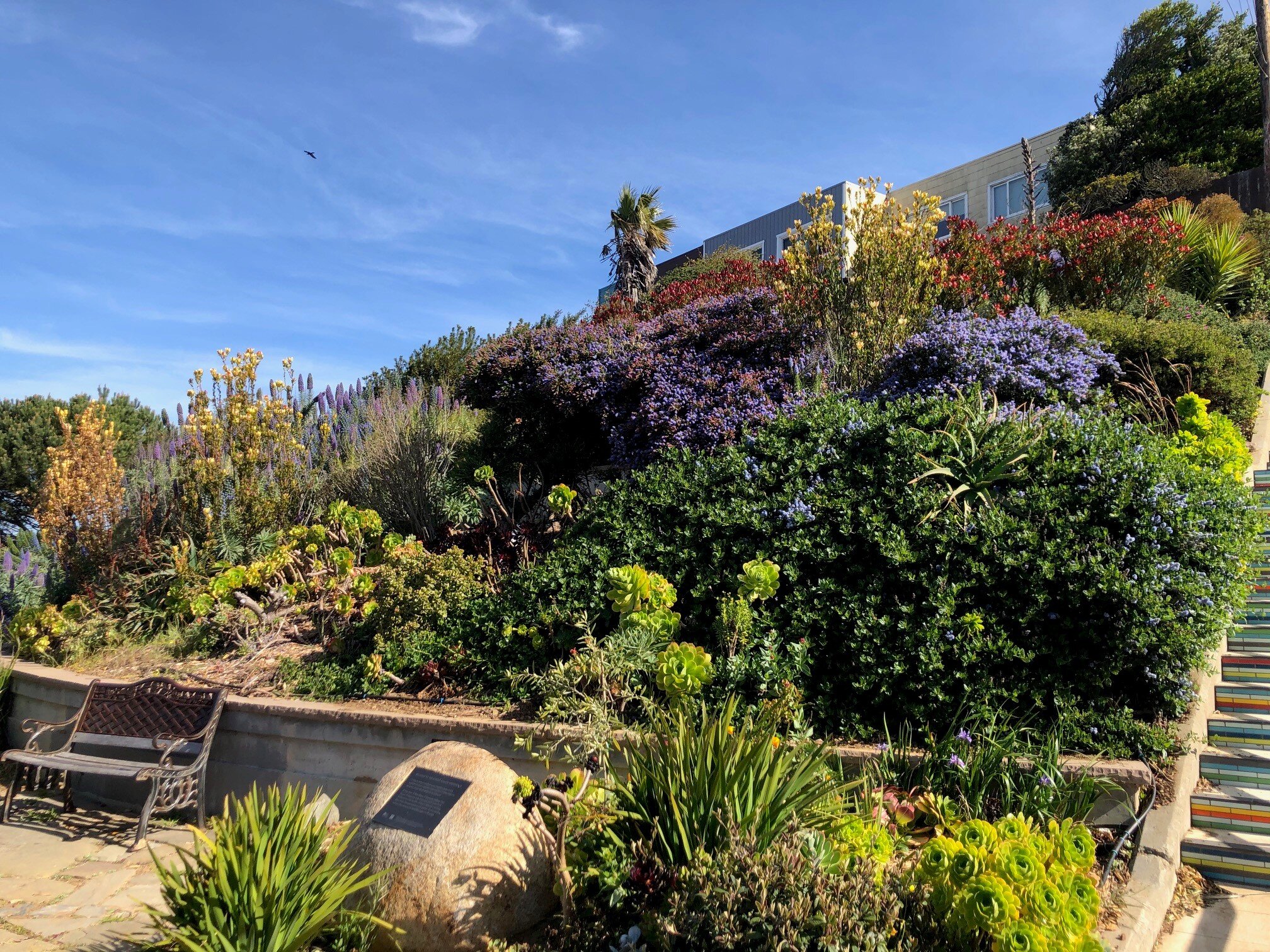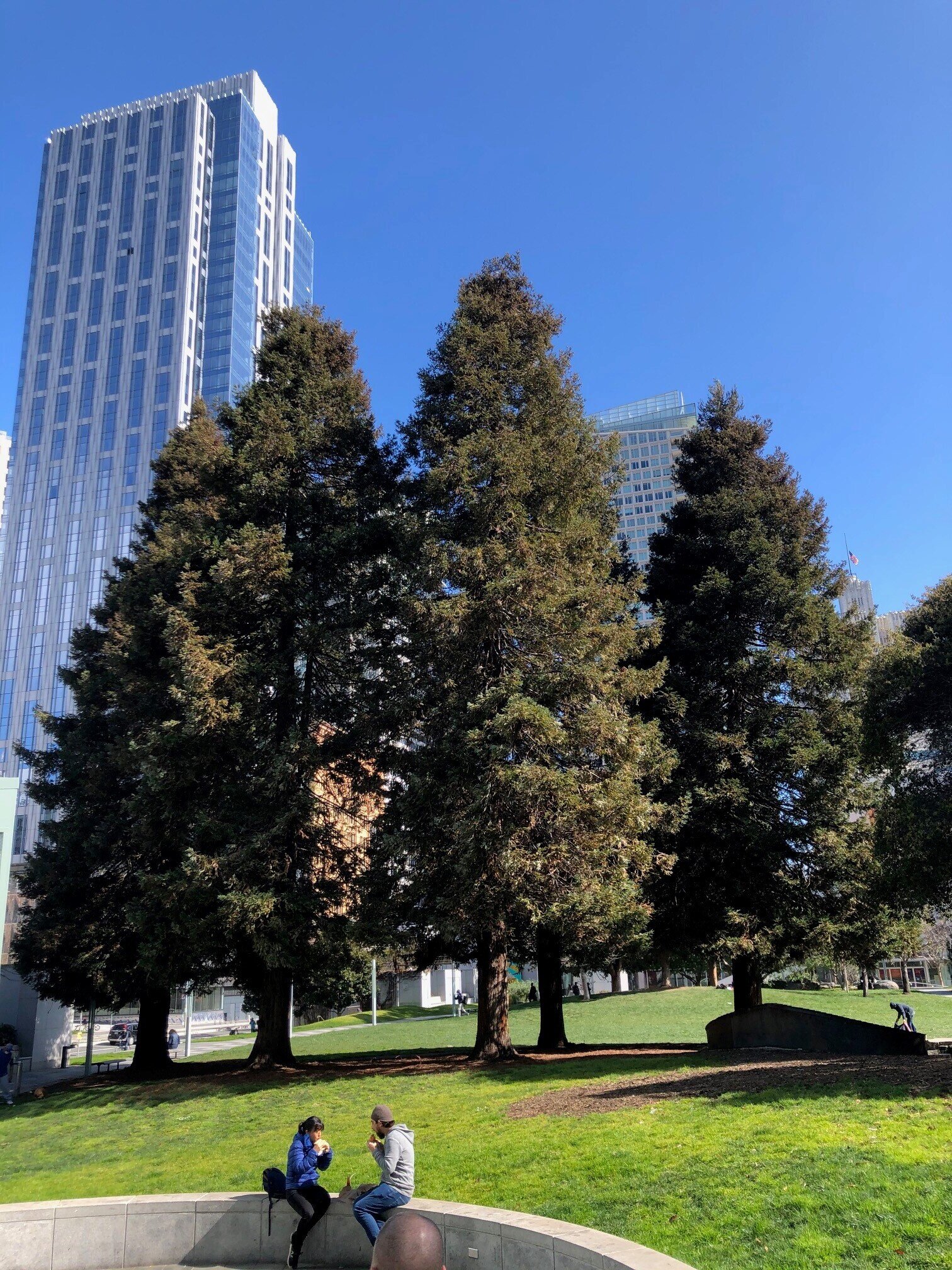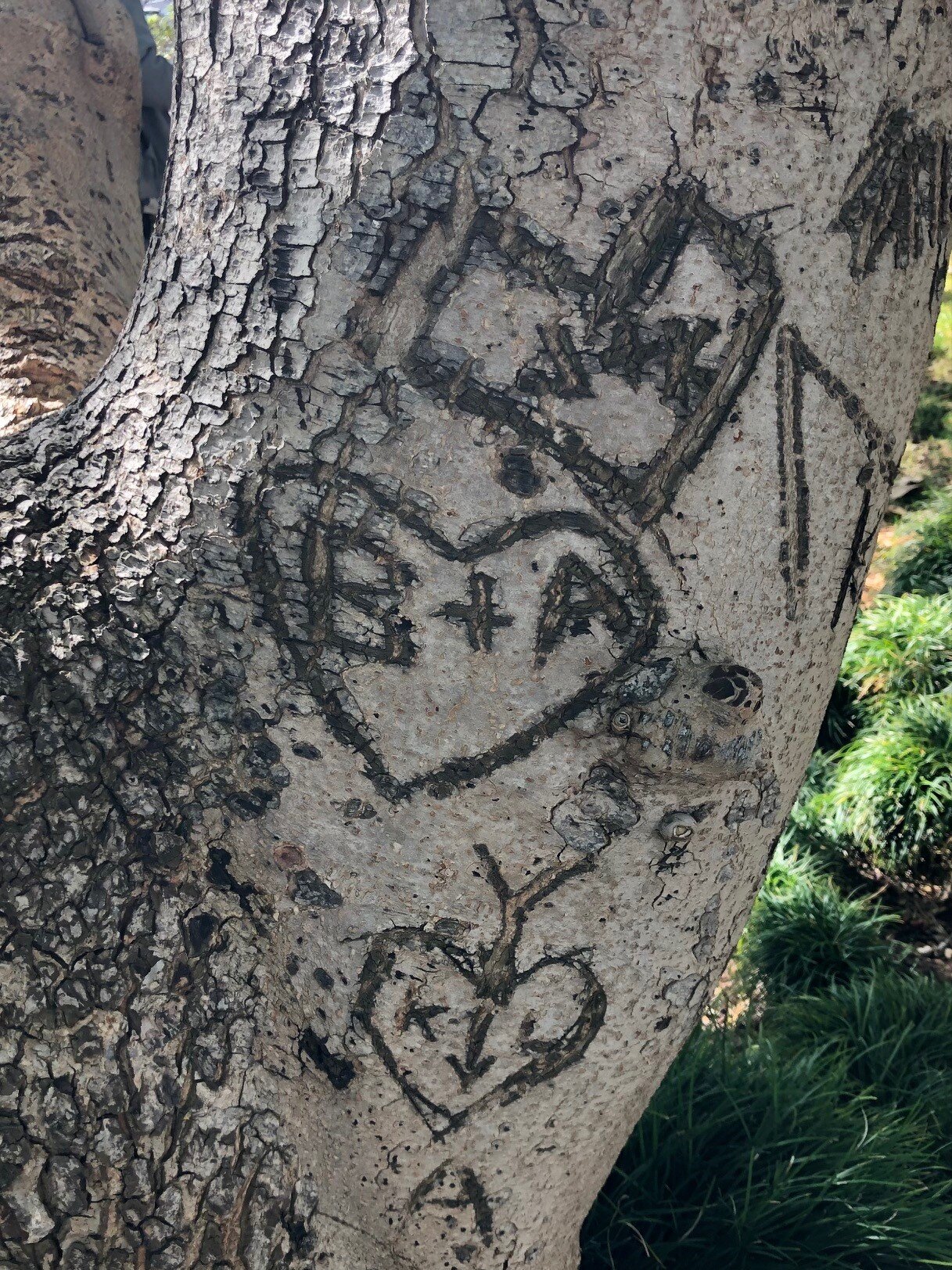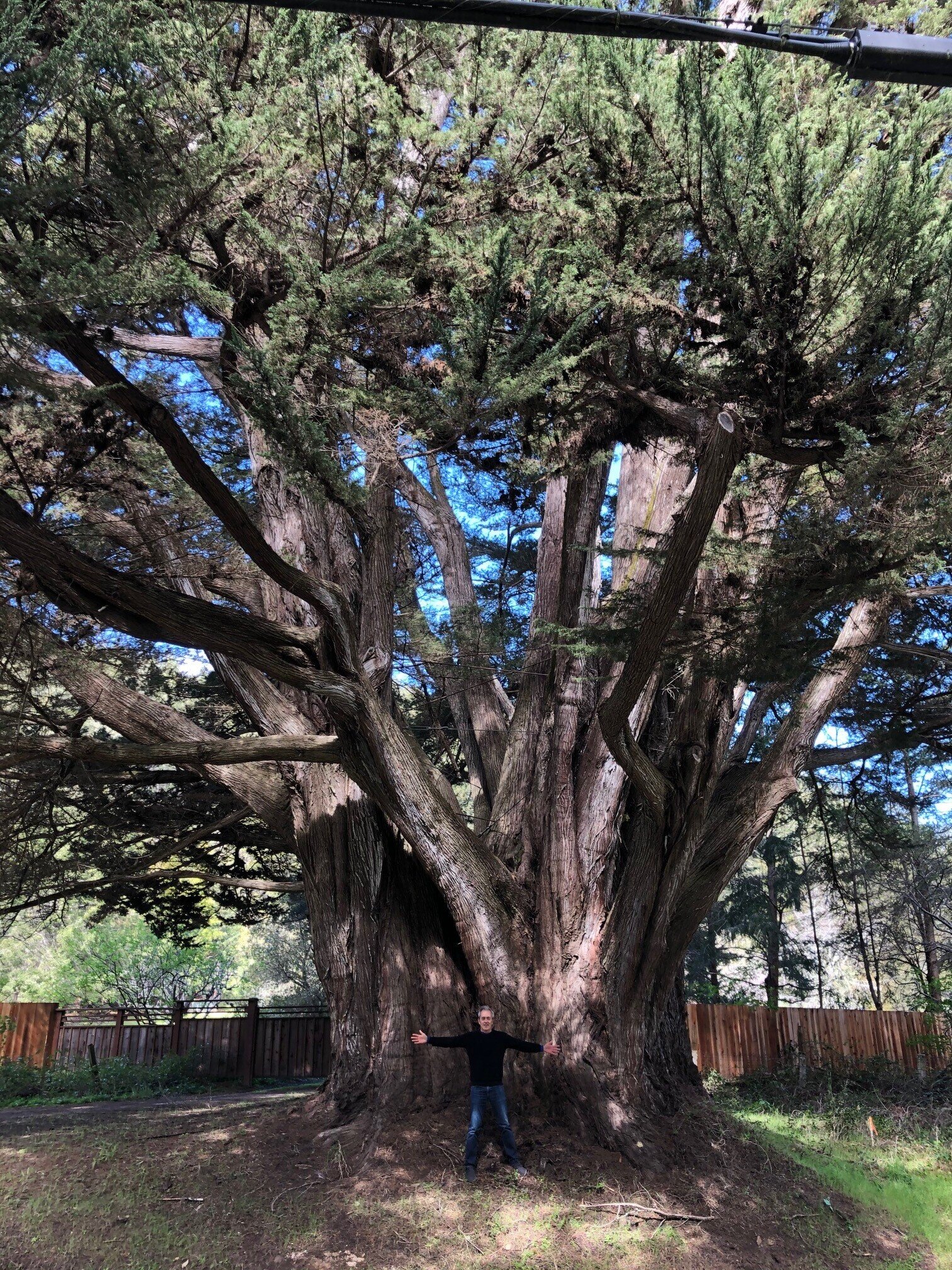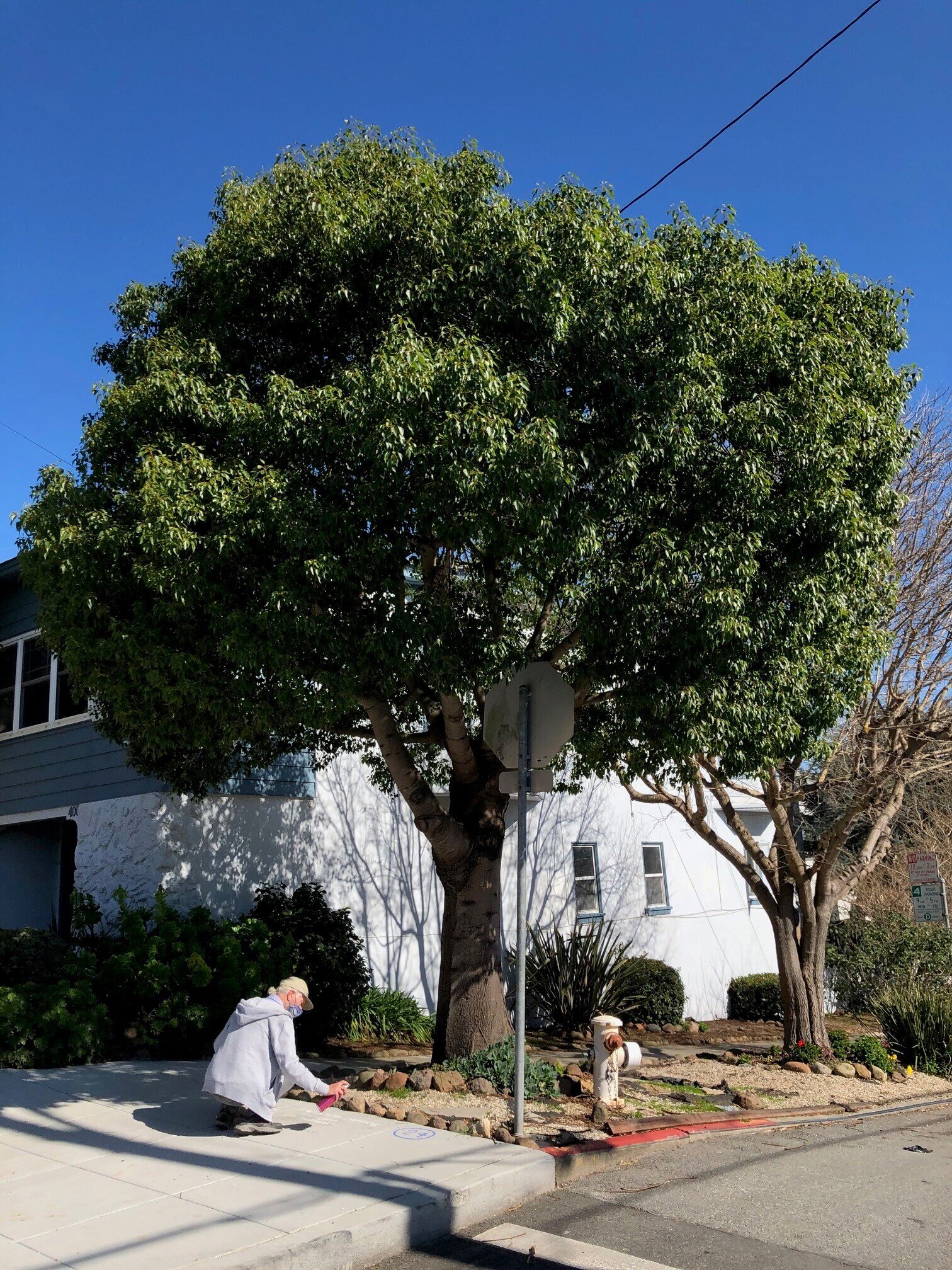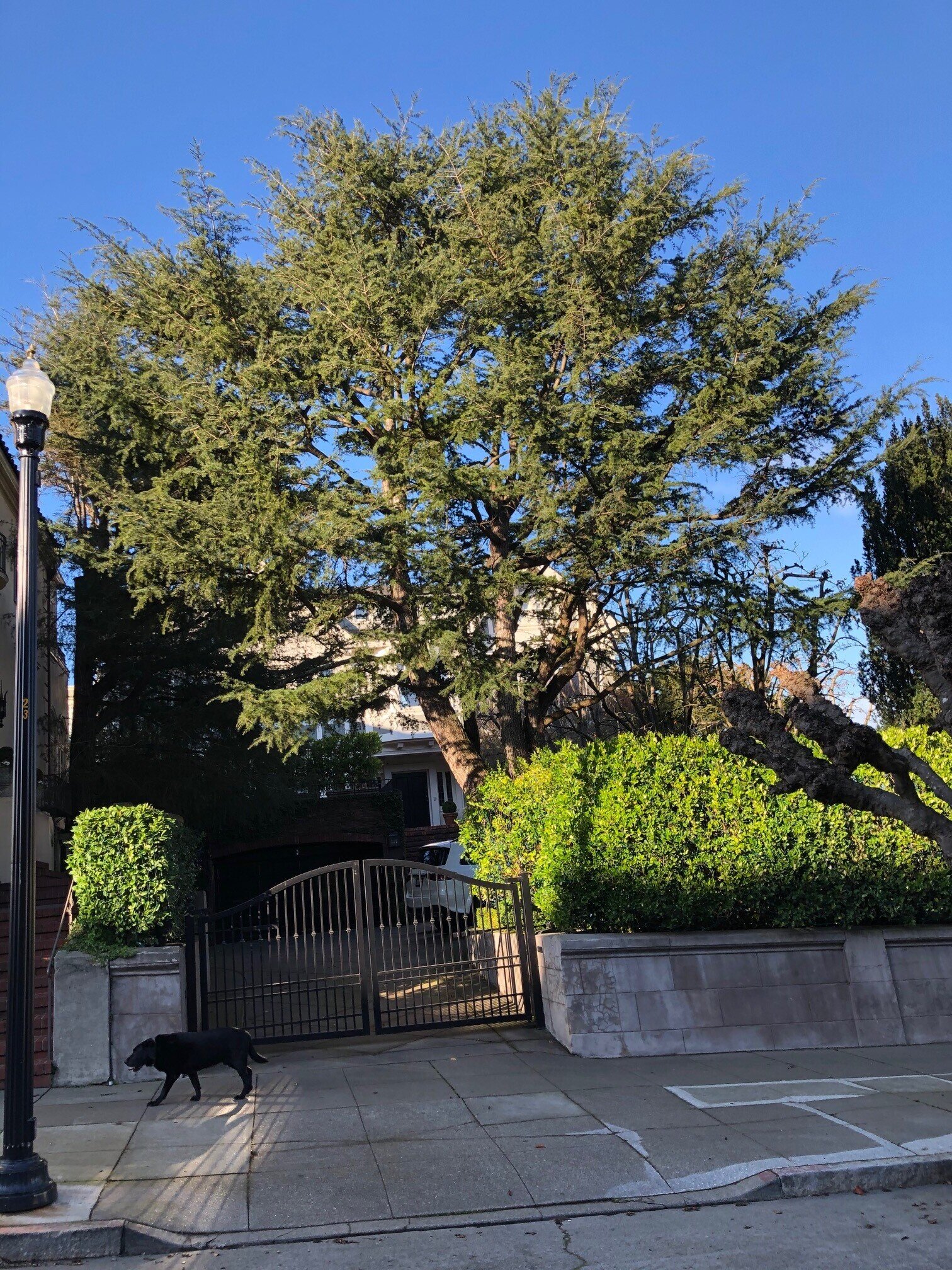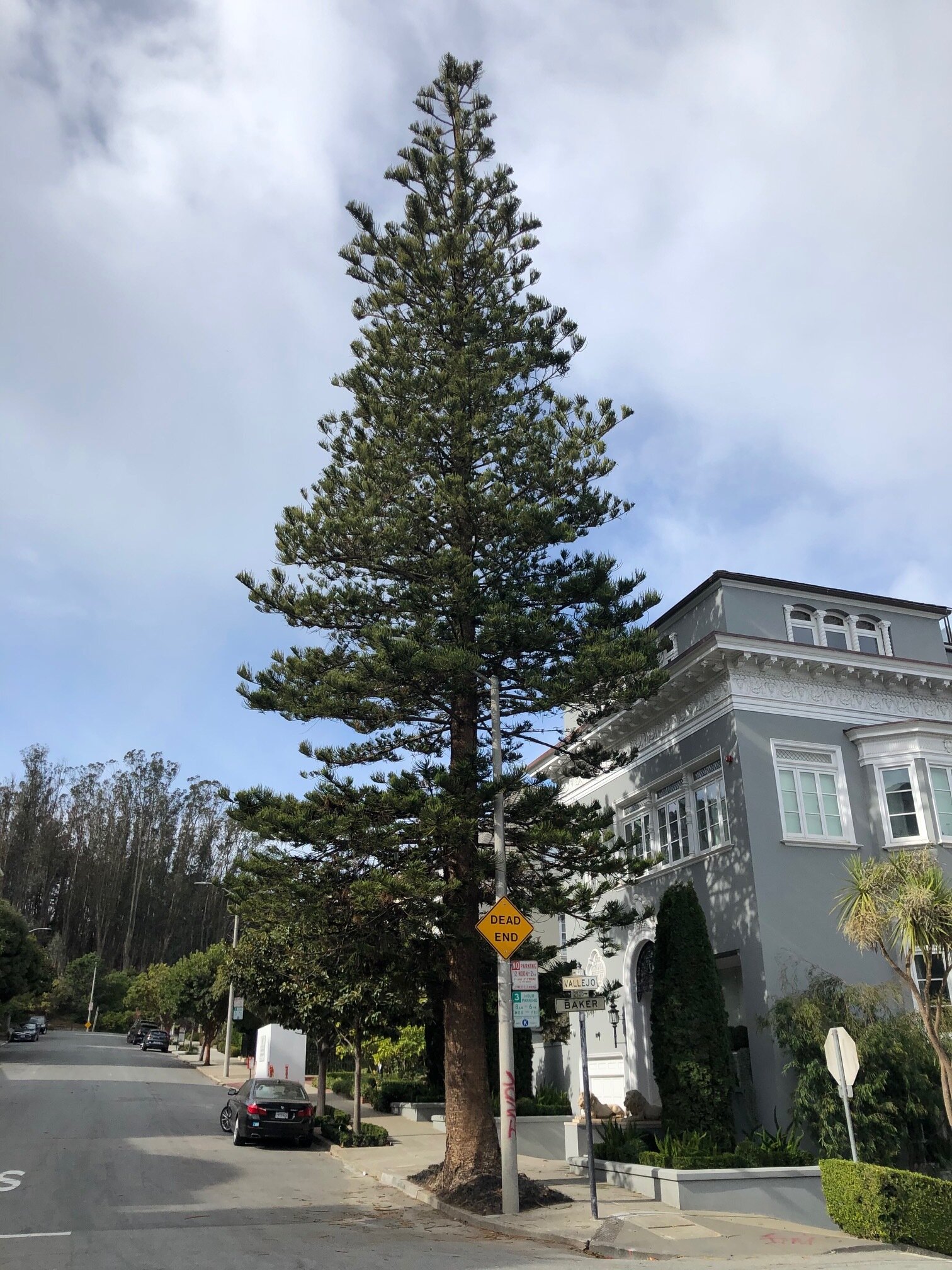Cole Valley "Social Distancing" Tree Tour 6-12-21
Cole Valley is one of San Francisco’s best-treed neighborhoods. It has not only great street tree density on almost every block, but also lots of truly spectacular trees - ones that belong on any list of San Francisco’s best. I have a Cole Valley tree tour in my book, Trees of San Francisco, and a good part of the tour below is taken from the tour in my book. However, this online tour has a different and much bigger footprint - it expands further south (to Waller Street) and further west (to Parnassus Heights) than the Cole Valley tour in the book.
I’ve lived in Cole Valley since 1989 (for 10 years at 17th and Belvedere, since then on Woodland Avenue) so I’ve had a long time to observe our streets and our trees. The tour below incorporates the 32 years of neighborhood-observing that I’ve done as a Cole Valley resident.
I planned this tree months ago, covering 41 trees. As usual, this tree tour was a joint effort of a trio of tree geeks - Jason Dewees (author of Designing with Palms) and Richard Turner (retired editor of Pacific Horticulture) joined me for the walk. They discovered some interesting trees along the way to supplement my 41, so the trees that aren’t integers (1.5, 3.5, etc.) are the ones we added on the fly as we went .
* * * * * * * * * *
Sweetshade tree (Hymenosporum flavum)
1. Corner of Parnassus and Cole Streets (Parnassus Street side). The tour starts at the Sweetshade tree (Hymenosporum flavum) in front of La Boulangerie, a Cole Valley favorite. I remember when the tree was planted in 1995, in front of what was then the iconic Tassajara Bakery. The flowers of this Australian tree are intensely fragrant; this is one of the largest sweetshade trees in the City, so unfortunately although the tree blooms most of the year, the flowers are far above nose-level.
Walk south on Cole Street to Grattan Street.
1.5. 1048 Cole Brazilian pepper tree (Schinus terebinthifolius), Brazil, Argentina, Paraguay
Turn left on Grattan Street.
2. 24 Grattan Southern magnolia (Magnolia grandiflora), Southeast USA.
At the corner of Belvedere, turn left.
3. 431 Belvedere Pindo palm (Butia odorata), Southern Brazil and Uruguay. This is a young tree (planted approximately 2010). Pindo palm are rare as a street trees in San Francisco, and this is the only one in the neighborhood. This tree is already demonstrating the characteristic blue-gray, graceful fronds of the species, which curve in toward the trunk.
3.5. 431 Belvedere Chocolate persimmon (Diospyros kaki ‘Maru’), northeast India to Southern China. It’s rare to see a persimmon tree on San Francisco streets - this tree was very recently planted, and I’ll be interested to watch it grow.
Cross Belvedere mid-block, and turn right to head south (uphill) on Belvedere.
4. 466-68 Belvedere Two Chinese elms (Ulmus parvifolia), East Asia. Of the 35 different species of elms, the Chinese elm is by far the most common in San Francisco, and the two at this address have been lovingly cared for by the owner. This species is noted for its beautiful bark, which comes off in puzzle-piece shapes. Just next door at 472 Belvedere is another elm - this one is a European elm (it’s incredibly hard to tell the various European elms apart, and I’m not enough of an expert to ID this one!).
Bark of a Chinese elm (Ulmus parvifolia) at 466-68 Belvedere
At Alma, cross to the west side of Belvedere, and continue uphill on Belvedere Street.
5. 515-517 Belvedere Cabbage palm (Cordyline australis), native to New Zealand. This tree looks like a palm, but it’s actually in the asparagus family of plants. There are several on Belvedere between Grattan and Rivoli.
6. Continue up Belvedere to 17th Street, and turn right (downhill). Before you do, look across 17th Street - the handsome residence across 17th Street at the corner is a converted church - formerly Saint Aidan’s Episcopal Church. The space was deconsecrated in the early 1960s, and was temporarily used by the Grateful Dead as a practice space until finally converted to a residence in the mid-1960s. It's now a beautiful 3-bedroom home with a loft-like giant room. And as you descend 17th, you’ll pass 4710 17th Street, where I lived from 1989-1998.
7. 4736 17th Cork oak (Quercus suber), Spain and Portugal. This is the largest cork oak in San Francisco (there’s a younger, smaller tree planted next door at 4746 17th). The bark of this tree provides the cork used in wine bottles - if you push your finger into the crevices of the bark, you’ll feel the spongy quality that is characteristic of the tree.
Canary Island pine (Pinus canariensis) on the right; a red flowering gum (Corymbia ficifolia) showing a bit of its orange flowers on left
8. 4810-12 17th Canary Island pine (Pinus canariensis), Canary Islands. This is the very tall pine tree between the two buildings at this address. Also at this address (planted in a sidewalk cut) is a red flowering gum (Corymbia ficifolia) from southwest Australia. Despite its name, the flowers of this tree can bloom red, orange, pink or white (or various shades in between). This tree has beautiful orange flowers when it blooms (I’ve noticed that this one tends to have peak bloom in August and September).
9. 1461 17th Brazilian pepper tree (Schinus terebinthifolius), Brazil. This address is also notable as the childhood home of Bernice Brown, mother of former Governor Jerry Brown - click here and search “1461” to see an interview with her remembrance of the building. I attended a political event on Woodland Avenue maybe 10 years ago, where former Governor Jerry Brown was in attendance, and he told the crowd that he was “conceived” in that building (!).
Pat Mondanton’s “Angel of Hope” at 1591 Shrader
Optional detour: at Shrader Street, if you want to take a 5 minute trip to a quirky piece of Cole Valley miscellany, head uphill on Shrader until you get to # 1591. The wooden sculpture at this address was built by philanthropist Pat Montandon when she lived here. Montandon hired sculptor Jack Mealy to carve a sculpture of an angel, which she titled "Angel of Hope", out of the trunk of a *huge* Monterrey Cypress to the left of the driveway . The tree had to come down for safety reasons after its neighbor on the other side of the driveway fell over in a 1997 windstorm, and in an inspired move, Pat decided to use the bottom 20 feet to create this work of art. Montandon at the time was in the process of writing a book about angels, which explains the reference. (If you’ve never been on Tank Hill, then you really should detour even further to the top of Shrader Street, then left to the end of Belgrave, then up the stairs for (IMO) the best view in San Francisco.) If you’ve taken this detour, now retreat back downhill on Shrader to 17th Street.
New Zealand Christmas tree, (Metrosideros excelsa) at 1221 Stanyan - a photo of the tree a few years ago. The tree is just beginning to bloom on 6/10/21
Continue on 17th until you reach Stanyan Street, cross Stanyan, and turn right. As you cross the street, look to the left - almost the entire long block of Stanyan between 17th and Belgrave at the top of the hill is planted with American sweetgum (Liquidambar styraciflua), native to a range from the Alleghenies through Mexico to Central America. These trees tend not to lose their leaves until the new leaves come in the Spring, so by December and January they are providing fall color.
10. 1221 Stanyan New Zealand Christmas tree, (Metrosideros excelsa) from New Zealand. San Francisco has thousands of New Zealand Christmas trees (it’s the City’s second most common tree); it’s popular for the showy red blossoms that peak in June each year. But unlike every other tree on our streets, this tree blooms yellow. It also happens to be my favorite individual tree in San Francisco (click here to see why), in part for its historical connection to the Victor Reiter (San Francisco’s most celebrated horticulturalist of the 20th Century) and his family.
9.5 1221 Stanyan Yarra burgan (Kunzia leptospermoides), Victoria, Australia (this is the small tree at 1221 Stanyan, to the right of the driveway. It’s a very rare and unusual tree in San Francisco - the only one we know of on the City’s streets.
Continue north (downhill) on Stanyan, and when you reach Rivoli Street, cross Stanyan.
11. The tree at the northeast corner of Rivoli and Stanyan is one of the City’s best primrose trees (Lagunaria patersonii), native to northern Australia, Lord Howe Island and Norfolk Island. As of this tour in June 2021, the tree just got a pruning from the City’s relatively new “StreetTreeSF” program.
11.5 1195 Stanyan Rimu (Dacrydium cupressinum), New Zealand (the tall conifer between 1195 and 1199 Stanyan). It’s a very rare tree in San Francisco, and is endemic to New Zealand (meaning it grows only there). 1195 Stanyan was the home of Victor and Carla Reiter, and we can see this rare New Zealand tree here thanks to them.
Continue downhill on Stanyan, cross Alma Street and head east on the north (downhill) side of Alma.
champak tree or joy perfume tree (Magnolia champaca) at 232 Alma - the biggest one in San Francisco!
12. The first tree you’ll encounter on Alma (at the northeast corner of Alma and Stanyan) is a multi-trunked rubber tree (Ficus elastica), native to South Asia. The four tree basins at this address originally had chinese photinia trees that all died simultaneously 20 years or so ago, and the residents of the corner building gradually filled the basins with whatever was handy (a houseplant rubber plant that was getting too big for indoors, a live Christmas tree that needed a home after December 25, some cacti and succulents for a third basin, etc.). The serendipity of the result here makes me smile.
13. 232 Alma - champak tree or joy perfume tree (Magnolia champaca), south and southeast Asia. This tree is a “City Champion” - the biggest champak tree in San Francisco! The whitish blooms of this tree have a beautiful fragrance.
Bailey’s acacia (Acacia baileyana) - photo taken in January when it was in bloom
Turn left on Shrader Street, and continue to the corner of Grattan.
14. 1201 Shrader Bailey’s acacia (Acacia baileyana) from eastern Australia. This corner address has two trees, this is the one with the bluish-grey foliage on the Shrader Street side; if you visit in January you’ll see brilliant yellow flowers.
Turn left on and head west on the south side of Grattan Street.
15. The last three trees before the corner of Stanyan Street are Victorian box trees (Pittosporum undulatum) from eastern Australia. When they’re in bloom, the small white flowers of this tree have a powerful fragrance - you know this tree is around the corner before you see it. This building (after its recent paintjob) is one of my favorites in the neighborhood - the owners have whimsically painted it four different shades of blue, from top to bottom - get a distance view of the building to see what I mean.
16. Turn right on Stanyan. At 1120-22 Stanyan is a young small leaf tristania (Tristanioposis laurina), also known as water gum, and native to eastern Australia. This is (by far) the most commonly planted tree in San Francisco. It’s not a show-stopper; its flowers aren’t eye-popping, and there’s no amazing fragrance to the leaves or flowers, but it has some important virtues: it is almost impossible to kill, suffers from no pests or diseases, doesn’t grow too tall or break sidewalks, and is very easy to prune and maintain.
Turn left on Stanyan for one short block, cross Woodland Avenue; turn left and head uphill on the west side of Woodland. When homes are sold in Woodland, “tree-lined street” almost always ends up somewhere in the marketing for the home. Our family lives on this street, so I have a bit of a resident’s pride in this street’s trees. :)
17. 25 Woodland Blue atlas cedar (Cedrus atlantica ‘Glauca’), Morocco and Algeria. This majestic tree is one of the best of its type in San Francisco.
18. 43 Woodland and 59 Woodland Soapbark trees (Quillaja saponaria), native to Chile. I’ve thought for a long time that this is an “undeservedly rare” tree in San Francisco - the very few mature soapbarks in the City are spectacular specimens. Soapbark trees have many similarities to our native coast live oak, which isn’t surprising because Chile has a similar Mediterranean climate to ours (dry summers, mild wet winters).
Italian stone pine (Pinus pinea) at 90 Woodland; Richard Neutra’s 1937 “Darling House” on the left
19. 90 Woodland two Italian stone pines (Pinus pinea) from the Mediterranean basin. This tree is the source of pine nuts and pignoli. The home at this address is one of the few Bay Area works of Richard Neutra, a noted Austrian modernist architect who designed dozens of homes (mostly in Southern California) from the 1920s to the 1960s. I’ve watched the last two owners of this home lovingly care for these two spectacular trees over the past 25 years.
At the end of Woodland, continue right on Willard Street and follow Willard down to Parnassus.
20. 1403 Willard The tree at this address is the largest victorian box tree (Pittosporum undulatum) in San Francisco, and possibly the largest in the state. Sadly, the tree is beginning to fail - its canopy is thinning, and I’m not sure it has too many more years with us. I hope it’s just the drought!
Cross Parnassus, and head east (downhill) on the north side of Parnassus.
21. 164-66 Parnassus Strawberry tree (Arbutus x ‘Marina’), a hybrid of two European species . This tree was first introduced to horticulture in San Francisco - the interesting San Francisco story can be found here. (There is another thriving and much bigger strawberry tree just around the corner at 1103-09 Shrader.)
Cross Shrader to the east side of the Shrader, and turn left.
fruits of the female ginkgo tree (Ginkgo biloba) at 1044 Shrader - photo was taken 12-31-20
22. 1044 Shrader ginkgo (Ginkgo biloba), China. Of the 1,000+ ginkgo trees in San Francisco, I bet fewer than 25 are female trees - this tree is a female, and it’s the only female ginkgo in the neighborhood. Female ginkgoes have malodorous fruit (it smells like vomit - caused by the release of butyric acid, which also gives rancid butter its smell). There are so few places in San Francisco where you can find the female of this species that I devoted a separate page in Trees of San Francisco to record all of the SF locations where I knew they existed. If you’re visiting from November to February, you should be able to find the fruits on the sidewalk beneath this tree. The other ginkgoes nearby (at 1050 Shrader, for example) are all male trees.
Canary Island palm trees (Phoenix canariensis) at 1024 and 1018 Shrader
23. 1024 and 1018 Shrader Canary Island palm trees (Phoenix canariensis), from the Canary Islands. This is the palm tree that lines upper Market Street, and is also found along the Embarcadero.
Cross Carl Street, and turn right (east) on the north side of Carl.
24. At 134-36 Carl, you’ll find the neighborhood’s largest Chinese hackberry trees (Celtis sinensis) from China, Korea and Japan.
Cross Cole Street, and turn left on east side of Cole.
25. 836 Cole Street. The very tall palm tree deep in a yard at this address is a rare hybrid of the Howea palm genus from Lord Howe Island in the South Pacific. Our palm expert, Jason Dewees, was amazed at this tree and estimates it’s at least 75 years old.
At Frederick Street, cross to the west side of Cole Street to 801 Cole, after which we’ll continue south on Cole.
brisbane box (Lophostemon confertus)
26. 801 Cole brisbane box (Lophostemon confertus), native to Eastern Australia I think this is the most commonly planted large tree in San Francisco at the moment. San Francisco’s Department of Public Works loves the tree - although it gets large, it doesn’t need much pruning or maintenance, it’s fairly friendly to sidewalks, and it’s generally resistant to pests.
27. 751-53 Cole Camphor tree (Cinnamomum camphora), East Asia. The leaves of this tree smell of camphor when crushed (the tree is an important commercial source of camphor).
28. 721 Cole Shamel ash (Fraxinus uhdei), Mexico and Central America I think this is one of the most spectacular trees of any kind in San Francisco, in addition to being (as far as I know) the largest shamel ash in the City. It shows why large trees are important in creating beautiful, tree-lined streets!
Cross Waller Street, and turn right (east) on Waller.
Silver dollar gum (Eucalyptus polyanthemos)
29. At the northeast corner of Cole and Waller Streets (on Waller, as you approach 1514-16-18 Waller) are several ceanothus (Ceanothus ‘Ray Hartman’), native (and endemic) to California. This tree doesn’t get very big, so these are some of the largest ceanothus street trees in San Francisco. They put out showy blue flowers when they bloom in late Spring.
30. 1550-52 Waller Red ironbark (Eucalyptus sideroxylon), eastern and southeastern Australia
31. 1514-16-18 Waller Silver dollar gum (Eucalyptus polyanthemos), Eastern Australia
Cross Clayton Street, turn right and head south (uphill) on the east side of Clayton.
32. The 700 block of Clayton is dominated by London plane trees (Platanus x acerifolia) , including all of the trees on the east side of Clayton from Waller Street to 744-46 Clayton. London planes are one of the most popular urban trees in the world - they thrive in New York, London and Paris. This is also the tree that lines Market Street from the financial district all the way to Castro Street.
32.5 774 Clayton English holly (Ilex aquifolium), Eurasia and North Africa
32.7 29 Frederick Myoporum, or ngaio in Māori (Myoporum laetum), New Zealand (tree is on Clayton at corner of Frederick; this species is dying all over San Francisco, due to an insect pest called thrips; note that the leaves are poisonous)
Cross Frederick, continuing on the west side of Clayton Street.
Chinese windmill palm (Trachycarpus fortunei) - 24 Carl Street
33. The first four trees past Frederick Street on Clayton are American sweetgum trees (Liquidambar styraciflua), native to a range from the Alleghenies through Mexico to Central America.
34. 812 and 816 Clayton Bronze loquat (Rhaphiolepis deflexa, syn. Eriobotrya deflexa), Southern China and Vietnam.
35. 822 Clayton Mock orange or tobira (Pittosporum tobira); southern Japan, China, Korea and Taiwan. Intensely fragrant flowers. We think this is a “City Champion” - the biggest of its kind in San Francisco!
At Carl Street, turn right and head downhill on the north side of Carl.
36. 24-26 Carl Chinese windmill palm (Trachycarpus fortunei), China This is the palm tree that will survive further north than any other palm - it can easily handle winters in Seattle and London.
37. 32-24 Carl Gold medallion tree (Cassia leptophylla), Southern Brazil I love this tree - it is a relatively recent introduction to San Francisco, and IMO is still “undeservedly rare”. The tree puts out spectacular grapefruit-size inflorescences of yellow flowers when it blooms. Congrats to the residents here on Carl Street for planting this very cool tree!
Cross Carl Street carefully, and then backtrack to head uphill (east) on Carl.
38. 17 Carl glossy privet (Ligustrum lucidum), native to Southern China. This tree has white, lilac-shaped flowers that bloom in early summer; the flowers attract bees (a friend who is a California native told me that as a kid, he called it the “bee tree”) but unlike lilacs, have an unpleasant odor.
glossy privet (Ligustrum lucidum)
Continue east (uphill) on Carl; turn right and head south on Clayton.
39. 893 Clayton There are two trees at this address - the one closest to the corner is a northern rata (Metrosideros robusta) from New Zealand - a very rare tree in San Francisco, and this tree is one of the largest in the City. The tree next to it at this address is a “botanical sibling” - a New Zealand Christmas tree (Metrosideros excelsa), also from New Zealand. Unlike the northern rata, which is extremely rare, the New Zealand Christmas tree is San Francisco’s 2nd most common street tree.
Turn right and head west on Parnassus.
39.5 22 Parnassus Karo (Pittosporum crassifolium), New Zealand
40. 58-60 Parnassus Two Italian bay trees (Laurus nobilis), native to the Mediterranean Basin. This is the culinary bay that is used in Mediterranean cuisine. These Parnassus Avenue trees are sending up basal shoots, or “suckers” from their trunks. An amazing coincidence: When I was researching this tree for my Trees of San Francisco book, I was amazed to discover a quote from the Roman poet Virgil in his Georgics, from 29 BC: “Beneath its mother’s mighty shade upshoots the bay tree of Parnassus”. (!) Grab one of the leaves from the suckers, crush and smell it - you’ll get the powerful bay fragrance immediately.
Cross Cole Street to the final tree on our tour, kitty-corner from the start of the tour.
Carob tree (Ceratonia siliqua) at Cole and Parnassus
41. Carob (Ceratonia siliqua), East Mediterranean Basin. In the Mediterranean, carob pods are often used as animal feed. The ripe and dried pod of the carob tree is often ground into carob powder, which is sometimes used as a chocolate substitute.
If you enjoyed this tour (or if you just want to help keep a local book in print!), there are a dozen of them in my book, Trees of San Francisco. The book is full of photos and info about 70+ trees that you’re likely to find on our City’s streets. Pick it up at any of our independent bookstores, or if you prefer, buy it online.




































